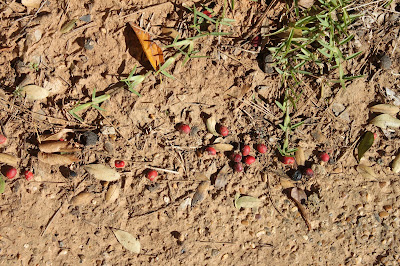 |
| Our Texas mountain laurel shrub is approximately 25 years old. In 1997, it was purchased from Home Depot, and Professor Ed Leuck planted it in this spot the following year. The lower foliage has been removed to allow for more visibility. The natural habit is much denser. You can see older pictures of its fuller form here. If so desired, Texas mountain laurel shrubs can be cultivated to serve as handsome, thick screens all year long. |
 |
| In mid-November we are noticing the fruits drying out and wrinkling. |
 |
| The fruit pods significantly darken upon drying out. |
 |
| These blackened seed pods are ready to split open. |
 |
| This bean pod has five compartments, in which we expect to find five seeds. |
 |
| The outer husk breaks up under just a little pressure. |
 |
| Individual capsules are long, measuring more than an inch in length. |
 |
| The large seeds are a handsome shade of red. Is there a hint of purple? |
 |
| Seeds measure approximately a half inch in length. |
 |
| The vibrant red seeds are conspicuous among green leaves. Be careful when handling or transporting these seeds. Sources agree that the seeds, along with other parts of the plant, are poisonous! |
 |
| Seeds are numerous and readily available for any desired attempts at germination. Pick up a handful and try your luck with getting these to sprout. These seeds are notoriously difficult to germinate, so good luck! It's worth it if you can figure out the trick. The USDA claims that "Fresh seeds reportedly germinate readily, requiring no scarification." So, try to find a mature pod still attached to the tree. |
 |
| Along with the attractive seed pods and the beautiful red seeds, we find these strange growths on the Texas mountain laurel. What are these odd, asymmetrical masses? |
 |
| These unusual growths are a product of fasciation, a type of abnormal growth, which is a known problem for Texas mountain laurel. |

